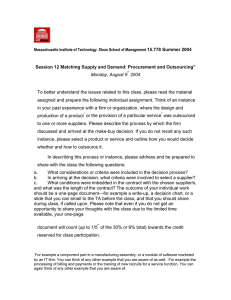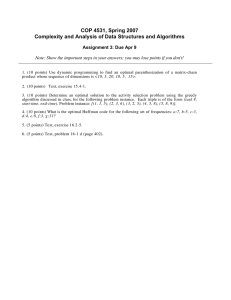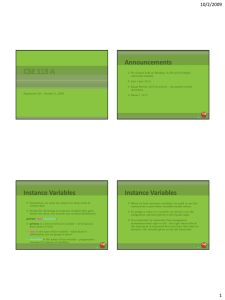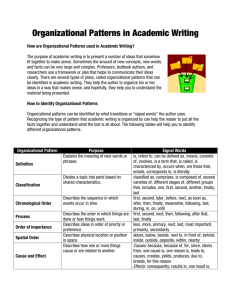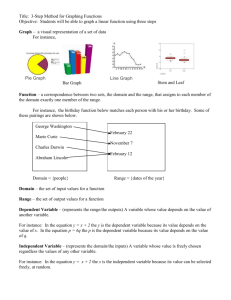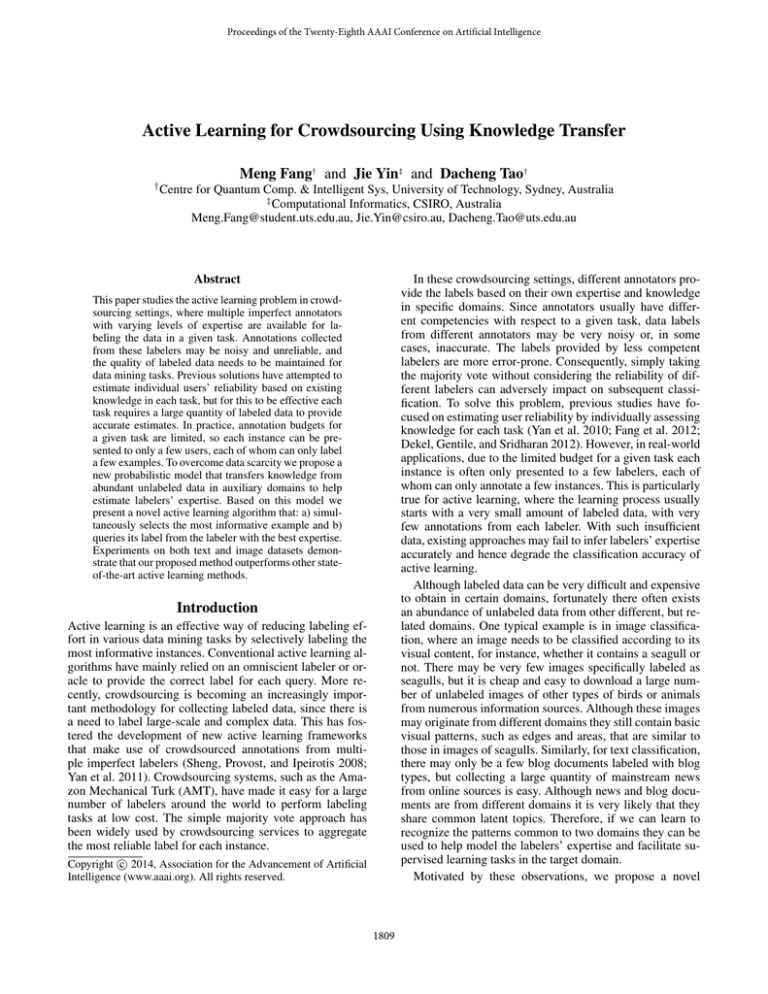
Proceedings of the Twenty-Eighth AAAI Conference on Artificial Intelligence
Active Learning for Crowdsourcing Using Knowledge Transfer
Meng Fang† and Jie Yin‡ and Dacheng Tao†
†
Centre for Quantum Comp. & Intelligent Sys, University of Technology, Sydney, Australia
‡
Computational Informatics, CSIRO, Australia
Meng.Fang@student.uts.edu.au, Jie.Yin@csiro.au, Dacheng.Tao@uts.edu.au
Abstract
In these crowdsourcing settings, different annotators provide the labels based on their own expertise and knowledge
in specific domains. Since annotators usually have different competencies with respect to a given task, data labels
from different annotators may be very noisy or, in some
cases, inaccurate. The labels provided by less competent
labelers are more error-prone. Consequently, simply taking
the majority vote without considering the reliability of different labelers can adversely impact on subsequent classification. To solve this problem, previous studies have focused on estimating user reliability by individually assessing
knowledge for each task (Yan et al. 2010; Fang et al. 2012;
Dekel, Gentile, and Sridharan 2012). However, in real-world
applications, due to the limited budget for a given task each
instance is often only presented to a few labelers, each of
whom can only annotate a few instances. This is particularly
true for active learning, where the learning process usually
starts with a very small amount of labeled data, with very
few annotations from each labeler. With such insufficient
data, existing approaches may fail to infer labelers’ expertise
accurately and hence degrade the classification accuracy of
active learning.
Although labeled data can be very difficult and expensive
to obtain in certain domains, fortunately there often exists
an abundance of unlabeled data from other different, but related domains. One typical example is in image classification, where an image needs to be classified according to its
visual content, for instance, whether it contains a seagull or
not. There may be very few images specifically labeled as
seagulls, but it is cheap and easy to download a large number of unlabeled images of other types of birds or animals
from numerous information sources. Although these images
may originate from different domains they still contain basic
visual patterns, such as edges and areas, that are similar to
those in images of seagulls. Similarly, for text classification,
there may only be a few blog documents labeled with blog
types, but collecting a large quantity of mainstream news
from online sources is easy. Although news and blog documents are from different domains it is very likely that they
share common latent topics. Therefore, if we can learn to
recognize the patterns common to two domains they can be
used to help model the labelers’ expertise and facilitate supervised learning tasks in the target domain.
Motivated by these observations, we propose a novel
This paper studies the active learning problem in crowdsourcing settings, where multiple imperfect annotators
with varying levels of expertise are available for labeling the data in a given task. Annotations collected
from these labelers may be noisy and unreliable, and
the quality of labeled data needs to be maintained for
data mining tasks. Previous solutions have attempted to
estimate individual users’ reliability based on existing
knowledge in each task, but for this to be effective each
task requires a large quantity of labeled data to provide
accurate estimates. In practice, annotation budgets for
a given task are limited, so each instance can be presented to only a few users, each of whom can only label
a few examples. To overcome data scarcity we propose a
new probabilistic model that transfers knowledge from
abundant unlabeled data in auxiliary domains to help
estimate labelers’ expertise. Based on this model we
present a novel active learning algorithm that: a) simultaneously selects the most informative example and b)
queries its label from the labeler with the best expertise.
Experiments on both text and image datasets demonstrate that our proposed method outperforms other stateof-the-art active learning methods.
Introduction
Active learning is an effective way of reducing labeling effort in various data mining tasks by selectively labeling the
most informative instances. Conventional active learning algorithms have mainly relied on an omniscient labeler or oracle to provide the correct label for each query. More recently, crowdsourcing is becoming an increasingly important methodology for collecting labeled data, since there is
a need to label large-scale and complex data. This has fostered the development of new active learning frameworks
that make use of crowdsourced annotations from multiple imperfect labelers (Sheng, Provost, and Ipeirotis 2008;
Yan et al. 2011). Crowdsourcing systems, such as the Amazon Mechanical Turk (AMT), have made it easy for a large
number of labelers around the world to perform labeling
tasks at low cost. The simple majority vote approach has
been widely used by crowdsourcing services to aggregate
the most reliable label for each instance.
c 2014, Association for the Advancement of Artificial
Copyright Intelligence (www.aaai.org). All rights reserved.
1809
users’ reliability based on the knowledge in each task. Yan
et al. (2010) directly used the raw features of instances to
calculate the reliability of labelers, while Fang et al. (2012)
modeled the reliability of the labelers using a Gaussian mixture model with respect to some concepts. However, these
methods require large amounts of labeled data for accurate
estimation of the labelers’ expertise. In practice, limited budgets mean that few labeled data are available from each labeler, limiting the use of these methods.
To further reduce labeling efforts for a given learning task,
transfer learning and active learning can be combined to
build an accurate classifier for a target domain by utilizing
labeled data from other related domains. Two studies (Shi,
Fan, and Ren 2008; Saha et al. 2011) used the source domain classifier to answer the target queries as often as possible so that the target domain labelers are only queried when
necessary. These methods, however, assume that the classification problem in the source domain shares the same label
space with that in the target domain. In our prior work (Fang,
Yin, and Zhu 2013), we used the labeled data from a similar
source domain to help model the labelers’ expertise for active learning. On the contrary, in this work we focus on transferring knowledge from abundant unlabeled data in auxiliary
domains to help estimate the expertise of labelers and improve active learning accuracy.
probabilistic model that addresses the active learning problem in crowdsourcing settings, where multiple cheap labelers work together for data annotation. The proposed model
effectively transfers knowledge from unlabeled data in related domains to help model the expertise of labelers; in
this way active learning in the target domain is enhanced.
Specifically, our approach uses sparse coding (SC) techniques to learn a succinct, higher-level feature representation of the inputs shared by the two domains (e.g., visual
patterns in images or latent topics in texts). These patterns
serve as a higher-level abstraction of the target data and better reveal the labelers’ hidden labeling expertise; this helps
to reduce errors in estimating the labelers’ expertise when
labeled data are limited in the target domain. Based on this
model we present a new active learning algorithm that simultaneously determines the most informative instance to label
and the most reliable labeler to query, making active learning more effective. Experiments on real-world data demonstrate that our proposed method outperforms other state-ofthe-art multi-labeler active learning methods, and transferring knowledge across domains boosts the performance of
active learning.
Related Work
According to the query strategy used, there are three categories of active learning techniques: 1) uncertainty sampling (MacKay 1992; Tong and Koller 2002), which focuses on selecting the instance that the classifier is most uncertain about; 2) query by committee (Freund et al. 1997;
Melville and Mooney 2004), in which the most informative
instance is the one that a committee of classifiers find most
disagreement; and 3) expected error reduction (Roy and McCallum 2001), which aims to query instance that minimizes
the expected error of the classifier. Most existing studies
have focused on a single domain and have assumed that an
omniscient oracle always exists that provides an accurate label for each query.
More recently, exploiting the “wisdom of crowds” has
gained attention for the purpose of multi-labeler learning
(Raykar et al. 2010); using these methods, labels are collected from multiple imperfect labelers rather than a single
omniscient labeler. As a result, the labels are inherently subjective and noisy with substantial variation between different
annotators. There have been attempts to improve the overall quality of crowdsourced labeling from imperfect labelers. For instance, Sheng, Provost, and Ipeirotis (2008) used
repeated labeling strategies to improve the label quality inferred via a majority vote. Donmez and Carbonell (2008)
introduced different costs to the labelers and selected an optimal labeler-instance pair to maximize the information gain
for a pre-defined budget. These methods have assumed that
the labelers’ expertise is known through available domain
information, such as associated costs or expert salaries.
Other attempts at multi-labeler active learning have focused on estimating the reliability of different labelers. One
approach has been to learn a classifier for each labeler and
approximate each labeler’s quality using confidence scores
(Crammer, Kerns, and Wortman 2008; Raykar et al. 2009).
Other recent studies have focused on modeling individual
Problem Definition
We consider active learning in a multi-labeler setting, where
the target data Xt = {xt1 , · · · , xtNt } and the source data
Xs = {xs1 , · · · , xsNs } exist. In the target domain there are
a total of M labelers (l1 , · · · , lM ) who provide the labels
for any instance xi ∈ Rn . For any selected instance xi we
denote the labeler set as Mi , the label provided by the corresponding labeler lj as li,j , and its ground truth label (unknown) as zi . In the source domain each instance x ∈ Xs
is unlabeled and may be drawn from a distribution different
from that of the target data. Unlike semi-supervised learning,
we do not assume that the unlabeled data from the source domain is assigned to the same class labels of the learning task
in the target domain.
To characterize a labeler’s labeling capability, we assume
that each labeler’s reliability of labeling an instance x ∈ Xt
is determined by whether the labeler has the necessary expertise with respect to some higher-level representation x0
of instance x. Essentially, the higher-level representation x0
is a learned projection of x onto a set of high-level patterns
(e.g., visual patterns in images or latent topics in texts). In
this way we define a labeler’s expertise as a weighted combination of these high-level patterns and by doing so we select
a labeler with the best expertise to label a selected instance.
Given the target data Xt and M labelers in the target domain, and a set of unlabeled data Xs from the source domain,
the objective of active learning is to select the most informative instance from the target data pool Xt and to query the
most reliable labeler to label the instance. In this way the
classifier trained from the labeled instances has the highest
classification accuracy in the target domain.
1810
Modeling Expertise of Multiple Labelers
logistic regression model to compute the conditional probability p(zi |x0i ) as:
Modeling the expertise of multiple labelers aims to select a labeler with the best labeling capability for labeling a queried instance. We therefore propose a probabilistic
graphical model to learn from multiple labelers, as shown in
Figure 1. The variables X, where xi ∈ X represents an instance, and Y , where yi,j ∈ Y , denotes the label provided by
labeler lj to instance xi , are directly observable. The other
variables—the ground truth label zi , and a labeler’s expertise ei —are hidden, and their values need to be inferred from
observed variables.
X’
E
Y
p(zi |x0i ) = (1 + exp(−γ T x0i − λ))−1 .
We also assume that for a given instance x0i the actual
label yi,j provided by the labeler lj is subject to both the
labeler’s expertise ei,j and the ground truth label zi of x0i .
We model the offset between the actual label yi,j and the
instance’s genuine label z as a Gaussian distribution:
p(yi,j |ei,j , zi ) = N (zi , e−1
i,j ).
Z
N
Knowledge Transfer From Unlabeled Data
Figure 1: Probabilistic graphical model for modeling multiple labelers with different expertise. Observed variables: X 0
– a learned higher-level representation of X (X – instances);
Y – labels provided by the labelers. Unobserved variables:
E – expertise of labelers; Z – ground truth labels.
We exploit transfer learning to extract useful knowledge
from unlabeled data in auxiliary domains to help learning
in the target domain. This meets two objectives: first, to
estimate labelers’ expertise more accurately (as defined in
Eq. (3)); and second, to improve the performance of the active learning task. In particular, we aim to discover a succinct, higher-level feature representation of the instances
that retains certain strong correlations between raw features
in order to minimize the divergence of the source and target domains. By mapping the data onto a basis space, vital
human characteristics are better retained from the previous
data, thus making the supervised learning task easier (Raina
et al. 2007; Pan and Yang 2010).
Formally, given the source data Xs and the target data Xt ,
our objective is to learn a new feature representation x0i for
each instance xi ∈ Xt in the target data.
For this purpose we use SC (Olshausen and others 1996;
Lee et al. 2007), which was first used as an unsupervised
computational model for finding succinct representations of
low-level sensory data. The basic goal of SC is to approximately represent input vectors as a weighted linear combination of a number of (unknown) basis vectors. These
basis vectors thus capture high-level patterns in the input
data. Specifically, given unlabeled data {x1 , · · · , xNs } with
xi ∈ Rn , the following optimization problem is solved:
X
X j
min
kxi −
ai bj k2 + βkai k1 ,
To characterize the labelers’ expertise, we introduce another variable X 0 to denote a higher-level feature representation of instances X. Since X 0 is a learned projection of X
it better reveals the labelers’ hidden expertise with respect to
some latent areas. Accordingly, our probabilistic graphical
model can be represented using the following joint probability distribution:
N
Y
p(zi |x0i )
i
Mi
Y
p(ei,j |x0i )p(yi,j |zi , ei,j ).
(1)
j
In our model, we assume that the expertise of a labeler is
dependent on the higher-level representation x0i of instance
xi . Since instance x0i is a new feature vector projected onto a
0(1)
0(K)
K-dimensional space x0i = (xi , · · · , xi ), we represent
a labeler’s expertise ei,j as a weighted linear combination of
x0i ’s higher-level features:
ei,j =
K
X
(k)
ekj x0 i
+ νj .
(2)
k=1
Given an instance’s higher-level representation x0i , we use
logistic regression to define the expertise of labeler lj with
respect to x0i as a conditional probability distribution:
p(ei,j |x0i ) = (1 + exp(
K
X
0(k)
ekj xi
+ νj ))−1 .
(5)
Intuitively, if a labeler has the better capability eij of labeling instance xi , the variance e−1
i,j of the Gaussian distribution
would be smaller. Thus, the actual label yi,j provided by the
labeler would be closer to the ground truth label zi of x0i .
So far we have discussed the calculation of conditional probabilities p(zi |x0i ), p(ei,j |x0i ), and p(yi,j |zi , ei,j )
in Eq. (1). Now we focus on how to compute the higherlevel representation x0 of instance x.
M
p=
(4)
i
j
s.t. kbj k≤ 1, ∀j ∈ 1, · · · , K.
(6)
Above, {b1 , · · · , bK }, where bj ∈ Rn , are a set of basis vectors. For input data xi , ai = {a1i , · · · , aK
i }, where
ai ∈ RK , is a sparse vector of coefficients with each aji corresponding to the basis vector bj . The second term is a L1
regularization that enforces the coefficient vector ai to be
sparse (Ng 2004).
(3)
k=1
For an instance x0i , its ground truth label is assumed to
solely depend on the instance itself. For simplicity, we use a
1811
Active Learning with Multiple Labelers
In our problem, we would like to find high-level patterns
shared by the source and target domains. Therefore, we apply SC simultaneously to the two domains by reconstructing
Xt and Xs using the same set of basis vectors. To achieve
this, we define our optimization objective function as:
min
X
(kxsi −
X
xsi ∈Xs
+
X
Based on our probabilistic model, in multiple labelers setting, active learning can select the most informative instance
and the most reliable labeler to query its label.
Instance Selection Given an instance xi in unlabeled pool
Xtu of target data, we first calculate its new feature representation x0i = {a1i , · · · , aK
i } by solving Eq. (7). To select the
most informative instance, we employ the commonly used
uncertainty sampling strategy using the posteriori probability p(zi |x0i ) from our graphical model:
aji bj k2 + β1 kai k1 )
j
(kxti −
xti ∈Xt
X
aji bj k2 + β2 kai k1 ),
j
s.t. kbj k≤ 1, ∀j ∈ 1, · · · , K,
i∗ = argmax H(zi |x0i ),
(7)
where {b1 , · · · , bK } with bj ∈ Rn , is a set of common
basis vectors shared by the two domains. This optimization
problem is convex and can be efficiently solved using iterative methods (Lee et al. 2007). We can then obtain a new feature representation of the target data, x0i = {a1i , · · · , aK
i },
as a sparse linear combination of the shared basis vectors
{b1 , · · · , bK }.
where
H(zi |x0i ) = −
k=1
j ∗ = argmax Cj (x0i∗ ).
After selecting the best instance and labeler, we query the
label for the instance. The active learning algorithm is summarized in Algorithm 1.
(8)
Algorithm 1 Active Learning with Multiple Labelers
Input: (1) Target dataset Xt (unlabeled set Xtu and labeled set
Xtl ); (2) Multiple labelers l1 , · · · , lM ; (3) Source dataset Xs ;
and (4) Number of queries allowed by the labelers (Budget)
Output: Labeled instance set L, Parameters Ω
1: Perform transfer learning to calculate x0i for each instance xi ∈
Xt (Eq. (7));
2: Train an initial model with labeled target data and initialize Ω;
3: q ← 0;
4: while q ≤ Budget do
5:
Given instance xi , we have its new feature representation
x0i ;
6:
i∗ ← the most informative instance from unlabeled pool
Xtu of target data (Eq. (12));
7:
j ∗ ← most confident labeler for instance xi∗ (Eq. (15));
8:
(xi∗ , yi∗ ,j ∗ ) ← query instance xi∗ ’s label from labeler lj ∗ ;
9:
L ← L ∪ (xi∗ , yi∗ ,j ∗ );
10:
Ω ← retrain the model using the updated labeled data;
11:
q ← q + 1;
12: end while
j
(9)
M-step: To estimate the model parameters, we maximize
the expectation of the logarithm of the posterior on z with
respect to p̂(zi ) from the E-step:
(10)
Ω
where Ω̂ is the estimate from the previous iteration, and
Q(Ω, Ω̂)
= Ez [log(p(x0i , ei , yi |zi ))]
X
=
Ezi [log p(ei,j |x0i ) + log p(yi,j |zi , ei,j )
i,j
+
log p(zi |x0i )].
(15)
j
p(ei,j |x0i )p(yi,j |zi , ei,j ).
Ω∗ = argmax Q(Ω, Ω̂),
(13)
We then rank the confidence values of all the labelers and
select the labeler with the highest confidence score to label
the selected instance:
where
Mi
Y
p(zi |x0i ) log (zi |x0i ).
Since the calculation of the posteriori probability p(z|x0 )
takes multiple labelers and their expertise into account, the
instance selected using Eq. (12) represents the most informative instance from the perspective of all the labelers.
Labeler Selection Given an instance selected using
Eq. (12), labeler selection aims to identify the labeler who
can provide the most accurate label for the queried instance.
According to Eq. (2), we compute the confidence of each
labeler as
K
X
Cj (x0i ) =
ekj aki + νj .
(14)
We next discuss the learning process for estimating the parameters of our proposed graphical model. Given the observed variables, including instances, their labels provided
by labelers, and the higher-level representation via transfer
learning, we would like to infer two groups of hidden variables Ω = {Θ, Φ}, where Θ = {γ, λ}, Φ = {ej , νj }M
j=1 .
This learning task can be solved using a Bayesian treatment
of the EM algorithm (Dempster, Laird, and Rubin 1977).
E-step: We first compute the expectation of the loglikelihood with respect to the distribution of the hidden variables derived from the current estimation of model parameters. Given current estimation of the parameters, we compute
the posterior on the estimated ground truth:
p(zi , ei , yi |x0i ) = p(zi |x0i )
X
zi
Parameter Estimation
p̂(zi ) = p(zi |x0 , ei , yi ) ∝ p(zi , ei , yi |x0i ),
(12)
i
(11)
We can solve the above optimization problem using the LBFGS quasi-Newton method (Nocedal and Wright 1999) to
compute the updated parameters.
1812
0.93
0.92
0.9
0.9
0.88
0.85
0.86
0.8
0.84
0.75
0.9
0.89
Average Accuracy
Average Accuracy
Average Accuracy
0.91
0.82
0.8
0.78
0.7
0.65
0.6
0.88
ALM+TrU
AL+gmm
AL+raw
ALM+MV
ALM
RD+MV
0.87
0.86
0
50
100
150
Number of Queries
200
250
(a) polarity
300
ALM+TrU
AL+gmm
AL+raw
ALM+MV
ALM
RD+MV
0.76
0.74
0.72
0
50
100
150
Number of Queries
200
250
300
(b) focus
ALM+TrU
AL+gmm
AL+raw
ALM+MV
ALM
RD+MV
0.55
0.5
0.45
0
50
100
150
Number of Queries
200
250
300
(c) evidence
Figure 2: Accuracy comparison of different algorithms on text data for the polarity, focus and evidence labels.
Experiments
and the second part, comprising 10,000 sentences annotated
by eight labelers, was used as the source data for transfer
learning. For labeling, each expert broke a sentence into a
number of fragments and provided a label to each fragment.
For the active learning task we used the focus, evidence,
and polarity labels in the target data and independently considered a binary classification problem for each label. The
fragments were set as the instances and their annotations
were treated as labels. Only the fragments that were segmented in the same way by all five labelers were retained,
and the fragments with less than 10 characters were removed. The stopwords were removed from them. As a result, 504 instances containing 3,828 features (words) were
available in the target data. The source data was processed
in the same way but labeling information was not collected.
To validate the effectiveness of our proposed algorithm we
conducted experiments on two real-world datasets annotated by multiple labelers: the first is a corpus of scientific
texts (Rzhetsky, Shatkay, and Wilbur 2009), and the other
is an image dataset collected via the AMT (Welinder et al.
2010). The inconsistency between multiple labelers makes
these datasets an ideal test-bed for evaluating the proposed
algorithm, referred to as ALM+TrU. Four other algorithms
are compared:
• RD+MV is a baseline method that randomly selects an
instance to query, and uses a majority vote to generate the
label for the queried instance;
• AL+raw is a state-of-the-art method for multi-labeler active learning that uses the raw features of the instances to
calculate labelers’ reliability (Yan et al. 2011);
Label
• AL+gmm models a labeler’s reliability using a Gaussian
mixture model (GMM) with respect to some concepts, as
proposed in the previous work (Fang et al. 2012);
Scientific
Generic
• ALM learns the same probabilistic model as ALM+TrU
but only using target data; it does not use transfer learning
to improve expertise estimation and classification;
Basis
cell, markers, progenitors
transcripts, express, neurobiology
express, human, cell
demonstrate, indeed, examined
Labelers
L1,L2,L3
L1,L4
L1,L4,L5
L3,L4
Table 1: Examples of learned text bases. Left: class label; Middle: most active bases containing largest magnitude
words with the class; Right: Labelers who have high expertise with respect to the bases (e > 0.7).
• ALM+MV uses the same transfer learning strategy as
ALM+TrU to learn new bases but only uses new representations of instances for classification. Since it does not
estimate labelers’ expertise it relies on a majority vote to
generate the label for the queried instance.
Figure 2 shows the classification accuracies of different active learning algorithms in terms of the number of
queries. Our ALM+TrU algorithm consistently outperforms
the other algorithms and achieves the highest accuracy. In
particular, its accuracy is much higher than others at the beginning of querying, indicating that when there are a limited
number of labeled data, transferring knowledge from a related domain boosts the accuracy of active learning. ALM
performs slightly better than AL+raw and AL+gmm even
though their performances are similar. ALM+MV is better
than RD+MV showing that the learned bases are good for
classification. ALM is inferior to ALM+TrU, which is intuitive because it utilizes majority vote to aggregate the labels
but does not consider the reliability of different labelers.
Table 1 shows examples of learned text bases for the focus
classification and labelers’ expertise. This illustrates that the
learned bases can discover the word relations for the class
In our experiments we report average accuracies based on
10-fold cross-validation. For each run, we initially started
with a small set of labeled data (30% of training data) before making queries for different active learning algorithms.
We used logistic regression as the base classifier for classification and evaluated different algorithms by comparing the
accuracies on the same test data.
Results Using a Text Dataset
We first carried out experiments on a publicly available
corpus of scientific texts annotated by multiple annotators (Rzhetsky, Shatkay, and Wilbur 2009). This corpus has
two parts: the first part, comprising 1,000 sentences annotated by five imperfect labelers, was used as the target data;
1813
and that the labelers’ expertise is correlated with the example bases. For example, labelers L1 and L4 have expertise on
different example bases while both of them also have high
expertise on the second and third example bases. This bagof-words representation are more useful for modeling the
expertise of a labeler than using raw features.
Results Using an Image Dataset
Experiments were also performed on an image dataset comprising 6,033 bird images collected via the AMT (Welinder et al. 2010). Labels were collected for two different bird
species, the Black-chinned Hummingbird and the Reddish
Egret, and three labels per image were obtained by three
different individuals. In all, 511 (219 vs. 292) images were
collected for classification and the rest of the images were
used as source data for learning the bases.
Figure 4: Left: Example images. Right: Example SC bases
learned from the unlabeled source domain: 120 bases and
each 20 × 20 pixels (small square).
0.84
0.83
Average Accuracy
0.82
0.81
0.8
0.79
0.78
0.77
0.76
Figure 5: Comparison of expertise of three different labelers: L1-, L2-4, L3-. The marked basis belongs to the
corresponding labeler’s expertise.
ALM+TrU
AL+gmm
AL+raw
ALM+MV
ALM
RD+MV
0
50
100
150
Number of Queries
200
250
300
Figure 3: Comparison of classification accuracy with respect
to different numbers of queries.
example, labelers L1 and L2 both have high reliability of
the pattern at 4th row and 2nd column, which is also a clear
“edge”. These abstract patterns somehow can be used to represent the labelers’ expertise.
A comparison of the accuracies of different algorithms
with respect to different numbers of queries is shown in
Figure 3. Our ALM+TrU algorithm is superior to the other
baselines, while RD+MV performs the worst. ALM and
AL+gmm achieve higher accuracy than AL+raw, while
AL+gmm is similar to ALM. This is because ALM+TrU,
ALM, and AL+gmm attempt to model the expertise of labelers in terms of abstract patterns or as a multi-dimensional
distribution, which better reveals the labelers’ knowledge.
However, since there is an underlying assumption with
AL+gmm that the expertise model follows a GMM distribution its performance is limited when used with complex data.
Furthermore, unlike ALM, by using unlabeled data from a
related domain our ALM+TrU algorithm yields the highest
classification accuracy in the active learning process.
Two example images from the dataset and some of the
learned bases are presented in Figure 4. The learned bases
are shown as “edges” in a small square, which is a higherlevel representation and more abstract than pixels. Each labeler’s expertise is shown in Figure 5. It marks three labelers’ top ten highest reliability bases using different symbols
, 4, and , respectively. It shows that labelers are more
sensitive to clearer “edges” than unclear ones. For example,
labeler L1 has higher reliability of the pattern at 1st row and
7th column than the one at 1st row and 6th column. Most unclear patterns are not recognized by labelers. Labelers also
share some expertise of the same patterns for images. For
Conclusion
Unlabeled data are often easy to obtain, while collecting
labeling data can be expensive or time-consuming. Active
learning is used to select the most informative instances
to label in order to improve accuracy with as few training data as possible. However, in the multi-labeler scenario,
the ground truth is unknown and even at the beginning of
querying very few labeled data are available. This poses
the challenge of how to model labelers’ expertise with only
limited labeled data and how to select both labeler and instance to make a query. To address these problems, here we
have proposed a new probabilistic model for active learning, in which multiple labelers are engaged. The proposed
model explicitly represents the expertise of labelers as a distribution over a higher-level representation learned by sparse
coding, and unlabeled data are exploited from a related domain to help estimate the labelers’ expertise and boost active learning. Based on this model our active learning algorithm can simultaneously select an optimal instance-labeler
to query. Experiments on two real-world datasets demonstrate that our proposed method is more effective than existing multiple-labeler active learning methods. Transferring
knowledge from a related domain can help model the expertise of labelers more accurately and improve active learning.
1814
Acknowledgments
Raykar, V.; Yu, S.; Zhao, L.; Valadez, G.; Florin, C.; Bogoni,
L.; and Moy, L. 2010. Learning from crowds. Journal of
Machine Learning Research 11:1297–1322.
Roy, N., and McCallum, A. 2001. Toward optimal active
learning through sampling estimation of error reduction. In
Proceedings of ICML, 441–448. ACM.
Rzhetsky, A.; Shatkay, H.; and Wilbur, W. 2009. How to get
the most out of your curation effort. PLoS computational
biology 5(5):e1000391.
Saha, A.; Rai, P.; Daumé III, H.; Venkatasubramanian, S.;
and DuVall, S. 2011. Active supervised domain adaptation.
In Proceedings of ECML/PKDD, 97–112. Springer.
Sheng, V.; Provost, F.; and Ipeirotis, P. 2008. Get another label? improving data quality and data mining using multiple,
noisy labelers. In Proceedings of SIGKDD, 614–622. ACM.
Shi, X.; Fan, W.; and Ren, J. 2008. Actively transfer domain knowledge. In Proceedings of ECML/PKDD, 342–
357. Springer.
Tong, S., and Koller, D. 2002. Support vector machine active
learning with applications to text classification. Journal of
Machine Learning Research 2:45–66.
Welinder, P.; Branson, S.; Mita, T.; Wah, C.; Schroff, F.; Belongie, S.; and Perona, P. 2010. Caltech-ucsd birds 200.
Technical Report CNS-TR-2010-001, California Institute of
Technology.
Yan, Y.; Rosales, R.; Fung, G.; Schmidt, M.; Hermosillo, G.;
Bogoni, L.; Moy, L.; Dy, J.; and Malvern, P. 2010. Modeling
annotator expertise: Learning when everybody knows a bit
of something. In Proceedings of AISTATS, volume 9, 932–
939.
Yan, Y.; Rosales, R.; Fung, G.; and Dy, J. 2011. Active
learning from crowds. In Proceedings of ICML, 1161–1168.
ACM.
This work is supported by Australian Research Council
Projects (FT-130101457 and DP-140102164) as well as a
supplementary postgraduate scholarship from CSIRO.
References
Crammer, K.; Kerns, M.; and Wortman, J. 2008. Learning
from multiple sources. Journal of Machine Learning Research 9:1757–1774.
Dekel, O.; Gentile, C.; and Sridharan, K. 2012. Selective
sampling and active learning from single and multiple teachers. The Journal of Machine Learning Research 13(1):2655–
2697.
Dempster, A.; Laird, N.; and Rubin, D. 1977. Maximum
likelihood from incomplete data via the EM algorithm. Journal of the Royal Statistical Society. Series B (Methodological) 1–38.
Donmez, P., and Carbonell, J. 2008. Proactive learning:
Cost-sensitive active learning with multiple imperfect oracles. In Proceedings of CIKM, 619–628. ACM.
Fang, M.; Zhu, X.; Li, B.; Ding, W.; and Wu, X. 2012.
Self-taught active learning from crowds. In Proceedings of
ICDM, 858–863. IEEE.
Fang, M.; Yin, J.; and Zhu, X. 2013. Knowledge transfer for multi-labeler active learning. In Proceedings of
ECML/PKDD. Springer. 273–288.
Freund, Y.; Seung, H.; Shamir, E.; and Tishby, N. 1997.
Selective sampling using the query by committee algorithm.
Machine learning 28(2):133–168.
Lee, H.; Battle, A.; Raina, R.; and Ng, A. Y. 2007. Efficient
sparse coding algorithms. In Proceedings of NIPS, 801–808.
MacKay, D. 1992. Information-based objective functions
for active data selection. Neural computation 4(4):590–604.
Melville, P., and Mooney, R. 2004. Diverse ensembles for
active learning. In Proceedings of ICML, 584–591. ACM.
Ng, A. Y. 2004. Feature selection, L1 vs. L2 regularization, and rotational invariance. In Proceedings of ICML, 78.
ACM.
Nocedal, J., and Wright, S. 1999. Numerical optimization.
Springer verlag.
Olshausen, B. A., et al. 1996. Emergence of simple-cell receptive field properties by learning a sparse code for natural
images. Nature 381(6583):607–609.
Pan, S. J., and Yang, Q. 2010. A survey on transfer learning. IEEE Transactions on Knowledge and Data Engineering 22(10):1345–1359.
Raina, R.; Battle, A.; Lee, H.; Packer, B.; and Ng, A. Y.
2007. Self-taught learning: transfer learning from unlabeled
data. In Proceedings of ICML, 759–766. ACM.
Raykar, V.; Yu, S.; Zhao, L.; Jerebko, A.; Florin, C.; Valadez,
G.; Bogoni, L.; and Moy, L. 2009. Supervised learning from
multiple experts: Whom to trust when everyone lies a bit. In
Proceedings of ICML, 889–896. ACM.
1815





